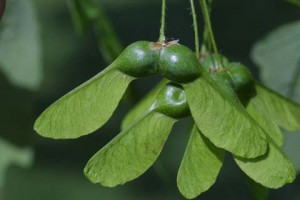Words and Woods
In this guest blog post, John Morrell talks about how stories shaped his view of the arboretum landscape.
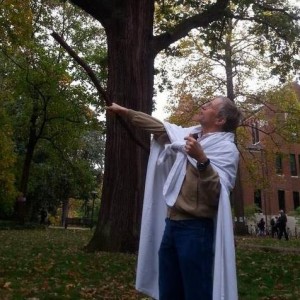
As I followed the online tree tour through the arboretum last week, admiring the changing of the leaves, I was reminded how much of my relationship to the trees at Vanderbilt has been shaped by walks I’ve taken with Steve Baskauf over the years. Through a collaboration with the Writing Studio in the fall of 2006, Steve began leading tree tours for a series called “Words and Woods,” writing workshops dedicated to exploring the ways that language shapes our understanding of the non-human world. For several years, Steve led at least one tour each semester, often varying the trees and themes of the tours to match the season (for a Halloween tour, he put together a tour of “ghost” trees – prominent campus trees from the past that have since been removed). Many of the stories from these tours are included on the arboretum website and in the online tree tours of Peabody and Main Campus.

One of my favorite of these stories concerns the Osage orange tree. This gnarly tree drops its large, lumpy fruits in the fall (they can be found lying on the ground around campus now). To the unfamiliar, they are noteworthy for their peculiarity. Green and roughly the size of a softball, firm and covered with bumps, often oozing a white, latex-like substance, these strange fruits pose a question – what could possibly eat them? They are sometimes known as horse-apples, and indeed, horses are one of the few animals known to eat Osage orange fruits. But horses are not native to North America, so it seems likely that the Osage orange tree’s original disperser was a large mammal that went extinct sometime after the arrival of humans in North America.
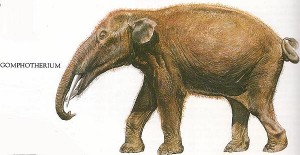
One candidate is the gomphothere, an elephant-like creature living in this region of North America as recently as 15,000 years ago. Explaining this hypothesis, Steve says he likes to think of the Osage orange tree as “waiting for the gomphothere” that no longer comes to eat its fruits. This phrase, whenever I think of it, has the uncanny effect of warping my sense of time, and I imagine gomphotheres roaming the Library Lawn, grazing on the Peabody Esplanade.

Other trees on campus have good stories too. The most famous, perhaps, is the stately Bicentennial Oak, an enormous bur oak and the only tree on campus known for certain to predate the founding of the university. Identifying this tree is a plaque dedicated in the bicentennial year of 1976, noting its recognition by the International Society of Arboriculture and the National Arborist Association as having lived during the American revolutionary period. Witness to history, trunk swollen with stories, the bicentennial oak stands as a living measurement of historical time.
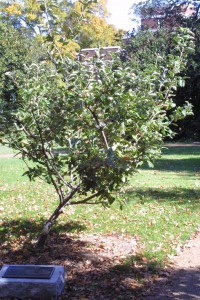
The other campus tree with a plaque was planted more recently but has a distinguished lineage of inspired contemplation – the Sir Isaac Newton Apple Tree, a descendant of the tree in England said to have prompted Newton’s thoughts on gravity. Presented to Vanderbilt by the National Institute of Standards and Technology in honor of Congressman Bart Gordon’s retirement, the Newton apple tree was planted in May 2011 on the occasion of the Senior Day address given by Kenyan political activist Wangari Maathai, who won the Nobel Peace Prize for her work with the Green Belt Movement in support of the environment and women’s rights.
As someone who studies literature, I’ve been intrigued by the possibility that one might read a landscape much as one would read a literary text. In this endeavor, I have found myself envious of ecologists and horticulturists, who seem able to read so much in the shape of a leaf or the texture of bark. Walking through the arboretum at Vanderbilt, the possibility of reading the landscape seems almost literal sometimes, so many of the trees are labeled with markers identifying them by their common and species names. Over time, though, I’ve come to the conclusion that for me, the process of becoming familiar with a landscape is as much about storying the landscape as it is about reading it. The stories I hear and tell about a landscape give shape and detail to the topographies of my mind; they give an emotional dimension to my internal map of the outer world.
During the Words and Woods tours, time during each tour was devoted to writing and discussion. For one fall tour, participants were encouraged to take short, poetic notes on small pads of paper. Each page of paper had room for just a few words, and at the end of the tour, participants contributed their writing to create a “pile of leaves.” A few of these notes are posted below.
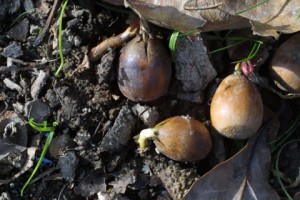 little acorn –
little acorn –
sprout fast,
before you get eaten!
.
.
.
.
.
.
.
.
R-strategist, sugar maple
lots of seeds –
leave it to the wind.
.
.
.
.
.
.

Weird Fruits & Seeds
They are
sometimes
the same
& in part
also dead,

the afterthought
of flowers,
the grandchildren
of trees,
mooching off the
family fortune
exactly according
to plan.
 John Morrell is a Lecturer in the English Department and a Pre-Major Adviser in the College of Arts and Science at Vanderbilt, where he completed his PhD in 2012. He studies American literature and literature and the environment, and he writes about climate change and science fiction. As a graduate student, John helped to coordinate the Words and Woods series at the Writing Studio. His current favorite tree is the September Elm near Benson Hall.
John Morrell is a Lecturer in the English Department and a Pre-Major Adviser in the College of Arts and Science at Vanderbilt, where he completed his PhD in 2012. He studies American literature and literature and the environment, and he writes about climate change and science fiction. As a graduate student, John helped to coordinate the Words and Woods series at the Writing Studio. His current favorite tree is the September Elm near Benson Hall.
